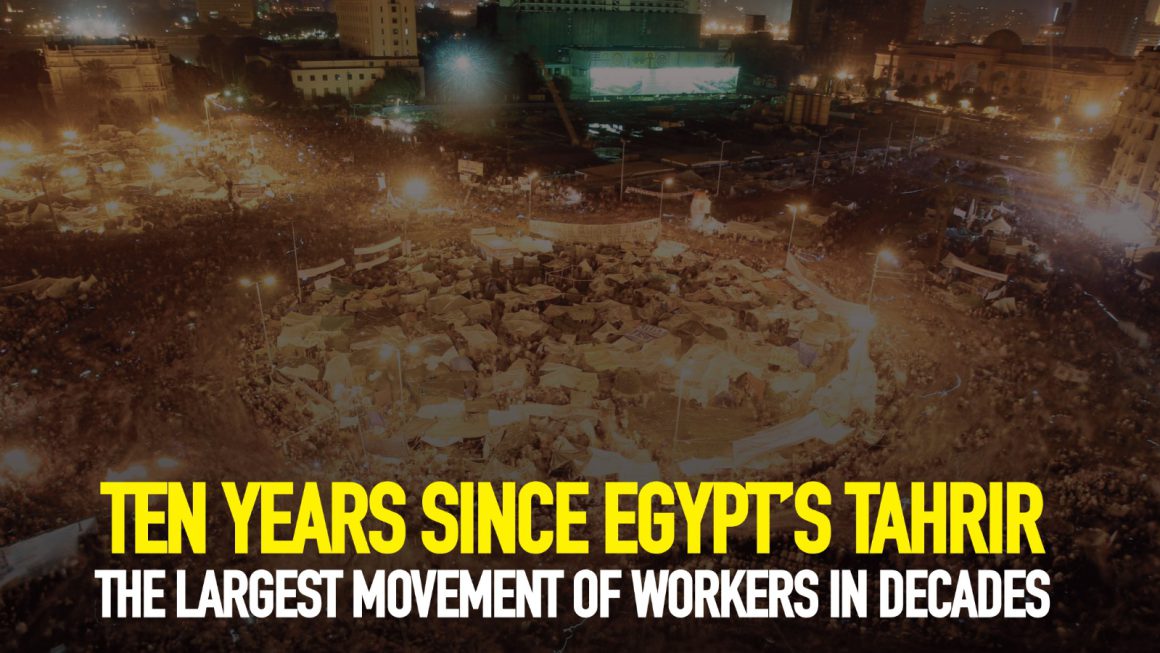By Igor Yasin — Participant in the events of 2011 and member of Sotsialisticheskaya Alternativa — our sister organsation in Russia
On 25 January 2011, around 15,000 people gathered in Tahrir Square in Cairo to demand fundamental political and social reforms. The police tried to disperse them but failed that day. And so began the 25 January revolution. Egypt became a key part of the ‘Arab Spring’. Ten years on, the situation there is grim: economic upheaval, terrorism, counter-revolution and repression. However, the latest protests in the region and in Egypt itself show that revolutionary ideas are alive and well.
Al-Sisi: new face of the old guard
The revolutionary wave in the Middle East was preceded by years of active struggle by Egyptian workers and youth, powerful strikes in enterprises, including by tens of thousands of workers in the region’s largest textile factories. Beginning on 25 January, a huge mass movement led within 18 days to the resignation of President Hosni Mubarak, who had ruled the country for 30 years.
The millions of Egyptians who took to the streets demanded “bread, freedom and social justice”. In the first couple of years afterwards, the Egyptian “street” was bustling, but it proved difficult to sustain the revolutionary gains.
In 2013, amid widespread dissatisfaction with the policies of the Islamists from the Muslim Brotherhood association, millions of people took to the streets again. The army’s top brass used the protest to their advantage and ousted Islamist President Mohamed Morsi, who had been elected in a relatively democratic election, but who quickly disappointed the masses.
The new leader, General Abdelfattah al-Sisi (field marshal since 2014), first brutally cracked down on dissatisfied Islamists. During the crackdown on demonstrations by supporters of deposed President Morsi in Cairo in the summer of 2013, some one thousand people were killed, according to human rights activists, and another 4,000 were injured. After this massacre, al-Sisi began to tighten the screws under the guise of restoring order and combating terrorism.
In June 2019, former president Mohammed Morsi died right in the middle of his trial without waiting for a final court decision on his case. Many right-wing conservative Islamist parties and organisations are now banned in the country, but they once again appear to be well-placed to oppose the repressive and anti-social regime. The ongoing crises are creating favourable conditions for their return to the political scene.
Gradually, amid mass fatigue and frustration, al-Sisi has been able to strengthen his grip, making his regime one of the most authoritarian and violent in the world. According to human rights activists, there are as many as 60,000 political prisoners in Egypt, including activists and journalists.
Egypt’s corona crisis
In January 2021, the number of confirmed coronavirus cases in Egypt exceeded 150,000, with 8,362 of those deaths. The World Health Organisation has called on Egyptian authorities to revise the estimate of coronavirus deaths because it relies only on test results from public clinics and does not take into account such indicators as the increased mortality rate. Excess deaths in the first wave of the pandemic in the country alone (May-July) reached 60,000 deaths.
The number of new cases of coronavirus in Egypt rose sharply in December. Even the government commission admits that the actual number of deaths from the coronavirus may be tens of times higher than officially announced.
Official figures say 240 doctors have died from the coronavirus. The Egyptian doctors’ union is concerned that the authorities have not acknowledged the deaths of some 200 more doctors who had not had a PCR test before they died. Yet all their symptoms indicate that the coronavirus was the cause of death. The union is seeking formal recognition of these deceased doctors as victims of the pandemic, so that their loved ones can receive all their entitlements.
The pandemic and quarantine restrictions have severely damaged many sectors of the economy, especially tourism and services. Before the revolution in 2010, Egypt attracted a record number of foreign tourists — almost 15 million — and the industry generated $12.5 billion, or 14.4% of all foreign exchange earnings. The tourism industry then employed 12% of all Egyptian workers.
After the revolution, there were fewer tourists: in 2016, after a series of major terrorist attacks, only 5.4 million tourists visited the country. It wasn’t until 2019 that the industry seemed to have recovered to previous levels, with the number of tourists exceeding 13 million and revenues ($12.6 billion) finally breaking the record of 2010. However, the corona crisis has caused a real collapse of the industry, with the number of tourists in 2020 dropping fourfold to 3.4 million. Egypt only had fewer tourists in the 1990s.
Trade unionist and left-wing activist Wael Tawfik says the authorities’ statements about the need to maintain “social distance” stand in stark contrast to the full-scale operation of all sectors of the economy, trade and transport. After the first wave of the pandemic, he said, the authorities had de facto abandoned restrictive measures.
“It has become clear that the authorities’ plan is to coexist with the pandemic, whatever the human cost, in order to fully harness the capitalist profit machine in industry, trade as well as construction — one of the government’s priority sectors in the last 5 years,” says Tawfik.
Protests 2019–2020
In autumn 2019, after a long political lull, there were massive protests in Egypt. The media activity of fugitive businessman and former actor Mohammed Ali played no small part in the growing outrage. He used to do contract work for the Egyptian army but then fled to Spain and from there began producing a series of videos in which he exposed the corruption of the al-Sisi regime and explicitly called for protests and the overthrow of the current regime in Egypt.
Although the call came from a businessman who used to be part of the elite, outrage also reached the poorer strata of Egyptian society. The pockets of protest were scattered across regions, from Marsa Matrouh in the northwest to Luxor in the south of the country. Fearing a repeat of events in 2011, the authorities blockaded Cairo’s central squares and protests engulfed the capital’s poorest suburbs.
The 2019 wave of protests did not last, but it demonstrated the weakness and divisiveness of the Egyptian leadership. Exactly one year later, new protests swept the country over the authorities’ exorbitant appetite for construction and real estate.
The government used the conditions of the coronavirus pandemic to crack down on uncoordinated development. It was essentially a declaration of war on the poorest, who erect their shanties on the scraps of land they have seized. In late August 2020, the eccentric dictator al-Sisi even threatened to send troops into all Egyptian villages to dismantle the “illegal constructions” erected on state farmland.
At the end of September, rural areas in many provinces were engulfed in protests. The confrontation reached the point of real battles and sieges of entire villages. Some consider these clashes to be the longest and most important opposition to the authorities since 2013. The government has been forced to retreat as a result, although this retreat may only be temporary.
‘Trump’s favourite dictator’ in difficulty
In April 2019, the authorities held a referendum in which almost 90% supported constitutional changes allowing al-Sisi to remain in power until 2030. However, even the official figures show that the picture of “popular support” is not so clear-cut: the turnout, even according to official figures, barely exceeded 44%. Opponents of the regime boycott all elections and referendums.
The recent victory of Joe Biden in the US presidential election was bad news for al-Sisi. During his campaign, Biden referred to al-Sisi as Trump’s favourite dictator. Relations with the U.S. had been very poor under Obama and Biden, but improved with the arrival of Donald Trump in the White House. The Egyptian dictator also found common ground with Vladimir Putin and gained the support of Saudi Arabia. But now Biden is back in the White House, now as president, the blockade has been lifted on Qatar, which Cairo considers the main sponsor of the Islamists, and the position of Turkey’s President Erdogan, who opposes al-Sisi, has been strengthened. Times are tough for Trump’s favourite.
The Egyptian president has never missed an opportunity to repress opposition forces. The authorities have continued their repressive policies, which include the practice of abusing the law on pre-trial detention and re-arresting activists in new cases. In Russia, such practices are referred to as “arrest carousels”.
The authorities took advantage of the situation to hold elections to the Senate in August. The upper house was abolished after the 2011 revolution but returned after constitutional amendments were adopted in 2019. The same amendments allowed al-Sisi to be re-elected president until 2030 and increased the power of the army and security forces.
Voters ignored these elections: just over 14% of eligible voters took part in the first round, even according to official figures. The Senate is formed in three parts: a third of the members were elected from a “closed list” formed by a pro-presidential party, the second third were taken by largely loyal single-member candidates, and another third will be appointed by the president himself. As a result, al-Sisi has gained an obedient “pad” for his regime.
Supporting business, not people
In November 2020, the Egyptian authorities reported incredible achievements in the context of the pandemic: the expected economic growth in 2020 is 3.6%, the Egyptian central bank’s reserves have increased and, on the contrary, the inflation rate has fallen. According to the official figures, unemployment fell by 2.3% in the third quarter of 2020 compared to 9.6% in the second quarter. However, these figures do not reflect a decrease of poverty and social unrest in the society.
According to earlier surveys, more than half of those employed in the private sector (55.7%) worked fewer days and hours during the pandemic, more than a quarter (26.2%) were underemployed and 18.1% had lost their job. Only a quarter said they had maintained their income level with the spread of the virus.
The Egyptian government has allocated about $230 million to support citizens without permanent jobs, and 14 times that amount to $3.2 billion to support big businesses, including large sums to support the stock exchange, export industry and tourism industry. Hotels and tourist facilities have been exempted from property tax, and gas and electricity prices have been reduced for large industrial enterprises. At the same time, the cost of utilities for citizens remained the same, although the poorest were hit hardest by the assembly ban.
Unemployment was previously expected to rise in the current crisis due to the loss of existing jobs and the lack of new job opportunities. At the end of 2019, there were 2.3 million unemployed in Egypt. The Ministry of Planning and Economic Development estimated that another 1.2 million could lose their jobs — mainly informally employed workers in trade, transport, manufacturing, tourism and services. As a result, the average unemployment rate for 2020 may have reached 11.5%.
Whether the government has really managed to avoid this by lifting many of the quarantine restrictions and pumping money into big business is still a question. A huge proportion of workers are employed in the shadow sector and they are also the most vulnerable in times of crisis.
According to the 2017–2018 census, around 4 million people in Egypt are employed informally in private enterprises (31% of all private sector workers), with another 11.7 million outside enterprises (45% of all private sector workers). According to the International Labour Organisation, the number of informal workers in Egypt reaches 16.5 million (63.3% of all private sector workers).
In addition, many Egyptians working abroad, mainly in the Gulf countries, have lost their jobs or sources of income. Their numbers cannot be precisely estimated, but their return and the drop in remittances back home will hurt the Egyptian economy.
Prospects for the movement in Egypt
“The labour movement is now going through its most difficult period since the 1990s, with the authorities not hesitating in the slightest to throw workers’ leaders behind bars. Not to mention the second wave of company privatisation which began with a law that curtailed workers’ rights and allowed a number of companies to be listed on the Egyptian stock exchange. Many consider this to be the first step towards selling them,” said trade unionist Wael Tawfik.
Since the 25 January revolution, independent unions have been empowered, grown and been activated. Today they are going through a difficult period and have been forced to retreat. However, the retention of some independent unions and the possibility of creating them outside the official federation is an important achievement of the 2011 revolution.
The left, like other opposition forces, is according to local activists also facing difficulties due to the repression. But rising social tensions and poverty will lead to a movement of outraged masses who find themselves in a situation where they simply have nothing to fear and nothing to lose.
No repression will help the authorities and the regime will be forced to make concessions, as has already happened after the arrest of two thousand people in September 2020. In early November, in anticipation of Biden’s victory in the US presidential election, an Egyptian court made the “unexpected” decision to release the 600 people arrested in September on their own recognisance.
The legacy of the Arab Spring, despite the bloody counter-revolutions and wars, is alive in the minds of the working masses. In 2019, protests swept Algeria and neighbouring Sudan and their authoritarian rulers resigned or were removed from power.
In 2021, a new round of protests gripped the cradle of the ‘Arab Spring’, Tunisia. In the first 10 months of last year Tunisia recorded 6,500 social protests, according to the Tunisian Forum for Economic and Social Rights. In January, thousands of people once again came out with the slogan “The people want to overthrow the regime”. Many of today’s protesters ten years ago were still children.
In 2011, it was the initial success of the Tunisian revolution that inspired Egyptian workers and young people to become active. Today the situation in the country is different, Egyptians have experienced many upheavals. However, the experience of the January 25 revolution is alive in the minds of the elders, and a new generation is already emerging on the political scene. The Egyptian masses have more than once proved their ability to rise up and change the course of the country’s history. And no dictator or repression has been able to stop them.












